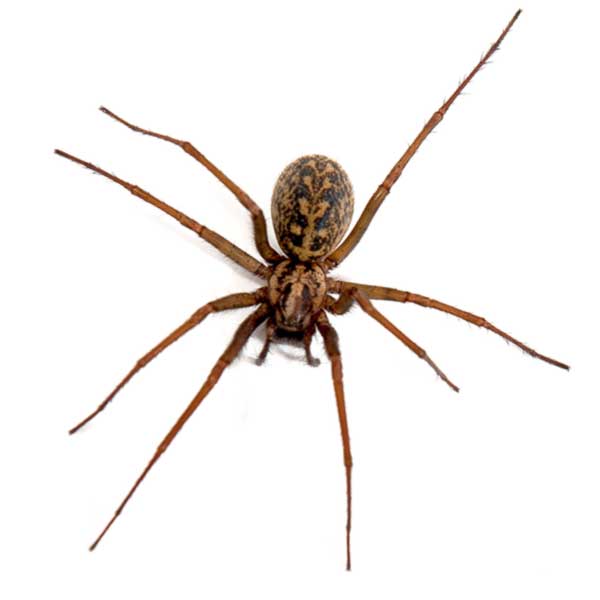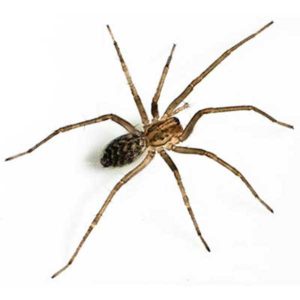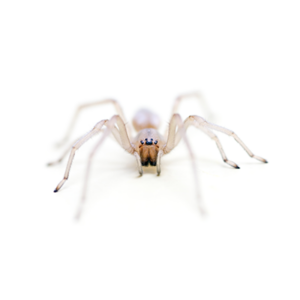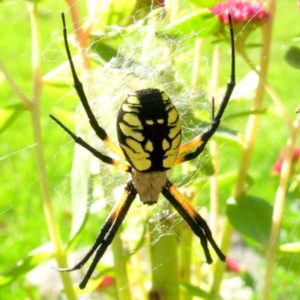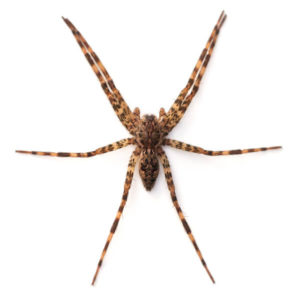Hobo Spider Identification
What Do Hobo Spiders Look Like?
Hobo spiders are a type of funnel-web spider commonly found in North Carolina and have a distinct appearance. They are medium-sized, with a body length of about 1/2 to 2/3 inches. Their coloring ranges from brown to rusty orange, and they often have a pattern of darker markings on their abdomen. Unlike some other spider species, hobo spiders have relatively smooth legs without prominent spines.
Signs of a Hobo Spider Infestation
Signs of a hobo spider infestation include sightings of the spiders themselves, often on lower walls and floors. Their webs are funnel-shaped and typically found in cracks and crevices, near foundations, and in basements.
Habitat, Diet, Life Cycle & Bites
Where Do Hobo Spiders Live?
Hobo Spiders typically reside in outdoor areas with dense vegetation, under rocks, and in woodpiles and are commonly found in residential environments such as basements, crawl spaces, and other dark, secluded areas of homes.
Originally from Europe, Hobo Spiders are well adapted to various habitats and create funnel-shaped webs for trapping prey, often in holes, crevices, or against walls. These spiders prefer damp and dark locations, and while they are often feared, they are less aggressive and harmful than commonly believed. Regular cleaning and reducing clutter can help minimize their presence in homes.
Diet of a Hobo Spider
Their diet mainly consists of insects that they capture in their funnel-shaped webs. Hobo spiders are ambush predators, waiting for prey to come near their web.
Life Cycle of a Hobo Spider
The life cycle of the hobo spider includes an egg, spiderling, and adult stage. Females lay eggs in the late summer or fall, which hatch the following spring. The spiderlings go through several molts before reaching maturity.
Hobo Spider Bites
Hobo spiders rarely bite people, and when they do bite, their bite is almost painless. It is no longer believed that hobo spider bites cause tissue damage or skin death (necrosis). Unlike other spiders that have been shown to cause this condition, hobo spider venom is not considered toxic to humans according to the Centers for Disease Control and Prevention. If you suspect you have been bitten and are concerned about any skin reaction, see a doctor for a proper diagnosis.
Are Hobo Spiders Dangerous?
Hobo spiders have been previously considered dangerous due to a belief that their bites caused necrosis. However, recent studies have shown that their venom is less harmful than previously thought, and they are not as aggressive as other spiders.
How to Get Rid of Hobo Spiders?
Reducing clutter and maintaining cleanliness in basements, garages, and around the perimeter of the house can help control hobo spider populations. Sealing cracks and crevices in the home’s foundation also prevents their entry. For persistent sightings of spiders contact our professional spider exterminators to assist.
Hobo Spider Prevention Tips
Prevent hobo spiders by keeping your home, especially basements and ground-level rooms, clean and free of clutter. Use window screens and door sweeps to prevent their entry from outside.
Need help with Hobo Spiders control?
FAQs
What Are the Symptoms of a Hobo Spider Bite?
Symptoms of a hobo spider bite may include initial pain, redness, and swelling. Severe reactions are rare but can include blistering.
Is a Hobo Spider a Brown Recluse?
No, hobo spiders and brown recluses are different species. Hobo spiders are part of the funnel-web family, while brown recluses are known for their violin-shaped marking. See our common spider species list to help you identify which spider you are dealing with.
What States Are Hobo Spiders In?
Hobo spiders are mainly found in the Pacific Northwestern United States.
What To Do If You Find a Hobo Spider?
If you find a hobo spider, it’s best to capture and release it outside. They are not aggressive, but it’s wise to avoid handling them.

